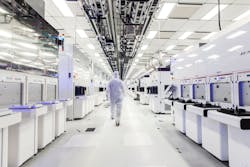Labor Shortage Looms Over U.S. Ambitions for American-Made Chips
The U.S. is pursuing an ambitious plan to revive America's manufacturing base for chips and has proposed tens of billions of dollars in subsidies to persuade companies to build new fabs. But a shortage of workers who possess the skills to run a modern chip plant threatens to derail U.S. ambitions, a new report warned.
For decades, the soaring cost of operating a fab in the U.S. has forced American chip makers to contract out more and more manufacturing to outside foundries. At the same time, chip makers have moved production operations out of the US in favor of Asia, specifically South Korea and Taiwan, lured by a combination of factors such as cheap labor and large subsidies to keep their costs in check.
As a result, the U.S. share of global chip production has slipped and stands at only slightly more than 10%.
Outsourcing has eroded the talent pool for semiconductor operations in the U.S., according to a new report from Eightfold, a startup offering intelligent software to help companies locate, recruit, and retain workers.
As Intel, Micron, Texas Instruments, TSMC, and other industry giants plan to build or expand American fabs in the coming years, the U.S. is facing a shortage of tens of thousands of workers that risks derailing its chip-making ambitions.
“Every industry has to be prepared for the future, but for semiconductor organizations, the situation is increasingly urgent,” Eightfold President Kamal Ahluwalia said in a statement. All the major chip makers operating in the U.S. were considered in its analysis of the industry’s workforce.
The report estimates the U.S. will have to construct up to 20 fabs, with output equal to around 5% of current global production levels, to handle the needs of its critical industries. The U.S semiconductor industry will have to increase its current workforce by a minimum of 50% to run the fabs, which translates to 70,000 to 90,000 workers, the report said.
A global shortage of chips has been devastating the electronics industry for months. Snarled supply chains have ravaged a range of other industries, including cars and consumer goods, causing delays in shipping products. Prolonged snags in the supply chain have spurred calls for billions of dollars in federal funding to bolster chip self-sufficiency and make the U.S. less dependent on the sector’s globe-spanning supply chain.
But expanding production capacity take tens of billions of dollars and thousands of skilled workers per plant, which can take years to build and equip with some of the world’s most expensive and complex machines.
The CHIPS for America Act, which is currently stalled in the House of Representatives, would roll out $52 billion in subsidies and other aid to lure more chip factories to the U.S. The law would, in turn, boost demand for workers to run them.
A portion of the proposed funds would be used to develop training programs for people that want to work in the sector. The objective is to help the U.S. build and maintain a “trusted and predictable talent pipeline.”
There are three major job categories in a modern fab. The first are production engineers, which design, run, test, and upgrade processes to improve yields and quality. Technicians in the fab's production operations department monitor and repair equipment in the fab. Other workers are responsible for logistics and support, ordering raw materials and managing shipments, among other jobs.
To address the looming talent shortage, tens of thousands of new workers with the skills to run a modern fab need to be trained and many others that already work in fabs will have to be "re-skilled" or “up-skilled.”
Semiconductor firms must identify jobs with declining relevance—such as production operations jobs that are becoming obsolete due to automation—and retrain workers for roles with a high degree of skills overlap, the report said.
"As reshoring efforts gain momentum, top talent that knows how to run a modern semiconductor fab will become the most valuable asset in the industry,” Ahluwalia said.
About the Author
James Morra
Senior Editor
James Morra is the senior editor for Electronic Design, covering the semiconductor industry and new technology trends, with a focus on power electronics and power management. He also reports on the business behind electrical engineering, including the electronics supply chain. He joined Electronic Design in 2015 and is based in Chicago, Illinois.

